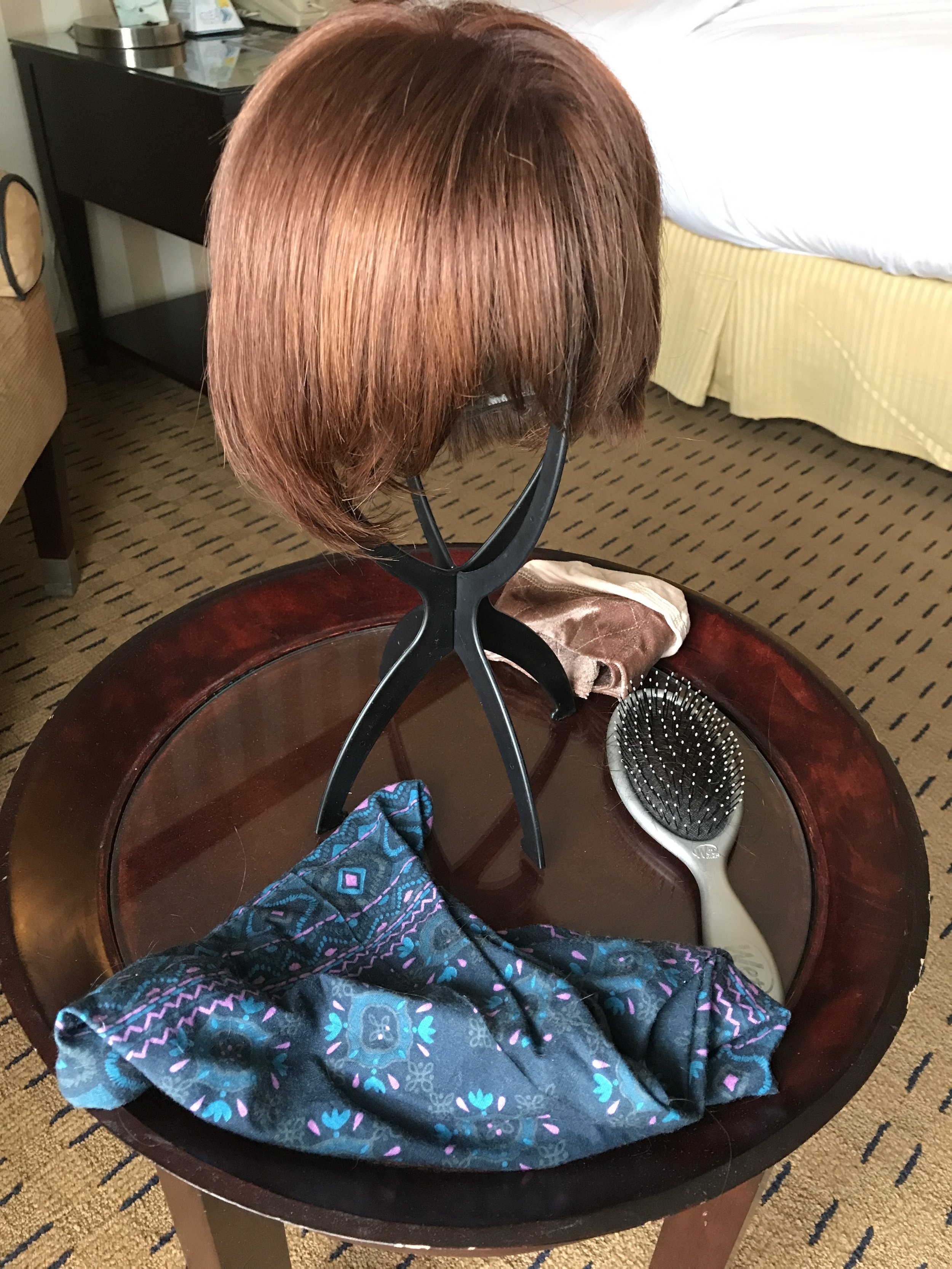So, you’ve got a fabulous ginger wig that you just can’t leave behind, even when you’re jetting off on your next adventure. But how do you ensure that your glorious mane stays intact during your travels? Well, worry not my fellow redhead enthusiast, because we’ve got you covered. In this article, we will explore some clever tips and tricks on how to protect your ginger wig while you’re on the go, ensuring that it remains as vibrant and beautiful as ever, no matter where your wanderlust takes you.
Packing and Transporting
Choosing the Right Packing Materials
When traveling with a ginger wig, it is essential to choose the right packing materials to ensure its safety. Opt for a sturdy box or a wig-specific travel case that provides ample protection against bumps and impacts. Avoid using plastic bags or flimsy containers that can potentially deform or damage the wig during transit. Additionally, consider using cushioning materials, such as bubble wrap or tissue paper, to provide extra padding and prevent any movement within the packing container.
Wrap the Wig Properly
Before packing your ginger wig, make sure to wrap it properly to prevent tangling, matting, or any other damage that may occur during transportation. First, gently brush the wig to remove any knots or tangles. Then, carefully fold the wig in half vertically, with the hair facing inward, and secure it with a rubber band or hair tie. Next, wrap the wig in a clean, soft cloth or hairnet to prevent dust and dirt from settling on the hair fibers. Be sure not to wrap it too tightly to avoid indentations or creases.
Protective Wig Case
Investing in a protective wig case is highly recommended, as it provides an excellent way to safeguard your ginger wig during your travels. Wig cases are specifically designed to fit and protect wigs, usually made of durable materials like hard plastic or fabric-lined hard shell cases. They often feature secure closures and cushioned interiors to prevent any potential damage. By using a wig case, you can rest assured that your ginger wig will be protected from external elements and maintain its shape and style throughout your journey.
Carrying as a Carry-On
If you want to keep your ginger wig close to you and ensure its safety, considering carrying it as a carry-on during your travels. This way, you can keep an eye on it and prevent mishandling or damage that can occur with checked luggage. Most airlines allow passengers to bring one small carry-on bag, so as long as your wig case fits within the required dimensions, it should be acceptable. However, it’s always a good idea to check with the airline beforehand to confirm their specific rules and regulations regarding carry-on items.
Storing in Checked Luggage
If carrying your ginger wig as a carry-on is not feasible or if you have multiple items to transport, you may need to store it in checked luggage. Ensure that your wig is well-protected by placing it in a durable, wig-specific travel case or box. To provide further protection, you can also wrap the wig in a soft cloth or hairnet before placing it in the case. Additionally, position the wig in a way that minimizes movement within the luggage, and consider placing it among soft clothing or other items that can act as cushioning.
Handling and Care
Avoiding Rough Handling
When handling your ginger wig, it is crucial to exercise caution and avoid any rough handling that may lead to tangling, matting, or even breakage. Treat your wig with care and gently hold it by the cap or base, avoiding pulling or tugging on the hair fibers. If you need to adjust the wig or reposition it, do so carefully to prevent unnecessary stress on the strands. Remember, proper handling is key to maintaining the longevity and overall quality of your ginger wig.
Handling with Clean Hands
Keeping your hands clean is essential when handling your ginger wig. Before touching the wig, wash your hands thoroughly to remove any oils, dirt, or residue that may transfer onto the wig and create a less desirable appearance. Avoid touching your wig excessively throughout the day, as the natural oils from your hands can transfer onto the hair fibers and potentially weigh them down or make them look greasy. By handling your wig with clean hands, you can help keep it looking fresh and vibrant.
Using a Wig Stand
Investing in a wig stand is a practical and convenient way to maintain the shape and style of your ginger wig. When you’re not wearing your wig, place it on a wig stand to help preserve its form and prevent unnecessary tangling or matting. Wig stands also provide an excellent opportunity to style and detangle your wig before wearing it. Look for a stand that is adjustable, sturdy, and has a shape that mimics the natural contours of a head to ensure proper support and storage of your ginger wig.
Avoiding Exposure to Extreme Temperatures
Ginger wigs, like any other wigs, should be protected from extreme temperatures to avoid potential damage. Avoid exposing your wig to excessive heat sources such as direct sunlight, open flames, or heated styling tools when not in use. Prolonged exposure to heat can cause the hair fibers to become brittle, frizzy, or even melt. Similarly, extremely cold temperatures can make the wig more prone to breakage or freeze the style. To maintain the quality and longevity of your wig, it’s important to store it in a temperature-controlled environment and avoid extreme temperature conditions.
Avoiding Exposure to Sunlight
When you’re not wearing your ginger wig, make sure to keep it away from direct sunlight. Prolonged exposure to the sun’s harsh rays can cause the hair fibers to fade, lose their vibrancy, and become brittle over time. If you plan to spend time outdoors or travel to sunny destinations, store your wig in a cool, shaded place or inside a protective case. Additionally, consider using a UV-protective spray specifically designed for wigs to minimize the sun’s damaging effects.

Maintenance and Styling
Brushing and Detangling
To keep your ginger wig looking its best and free from tangles, regular brushing and detangling are essential. Start by gently brushing through the wig’s strands, working from the ends upward to prevent unnecessary pulling or breakage. Use a wide-toothed comb or a wig brush specifically designed for synthetic or human hair wigs to avoid damaging the fibers. If you encounter any knots or tangles, hold the hair above the knot and carefully detangle it with your fingers or a comb, working through it gradually.
Using Heat Styling Tools with Caution
While ginger wigs can often withstand some heat styling, it’s important to use caution when using heat tools to avoid damaging the fibers. Check the manufacturer’s guidelines to determine the maximum heat the wig can tolerate. Always use a heat protectant spray before applying heat and adjust the tool to a low or medium setting. Avoid using excessive heat or leaving the tool in one area for too long. Opt for heat-free styling methods whenever possible, such as using foam rollers, braiding, or pinning the wig to achieve desired styles.
Avoiding Moisture Damage
Excessive moisture can cause damage to ginger wigs, especially those made from synthetic fibers. Avoid exposing your wig to rain, high humidity, or direct contact with water, as this can lead to frizz, matting, or even mold growth. If your wig does get wet, gently blot the excess moisture with a clean towel and allow it to air dry completely before styling or storing. Consider using a dry shampoo or a specifically formulated wig shampoo to refresh and cleanse your wig without the need for water.
Applying Wig-Specific Products
Using wig-specific products can greatly enhance the appearance and longevity of your ginger wig. Look for products specifically formulated for wigs, such as shampoos, conditioners, detanglers, and styling sprays. These products are designed with the unique needs of wigs in mind and can help maintain the texture, shine, and overall health of the hair fibers. Avoid using regular hair products that may contain harsh chemicals or ingredients that can cause damage to the wig. When using any product, always follow the manufacturer’s instructions for best results.
Styling and Restyling Techniques
One of the advantages of wearing a ginger wig is the ability to experiment with different styles. From classic updos to loose waves, the options are endless. When styling or restyling your wig, make sure to use gentle techniques to avoid unnecessary strain or damage. Avoid using excessive force, tight hairstyles, or intricate braiding that may cause tension on the wig cap or pull the hair fibers. It’s always helpful to watch tutorials or seek advice from wig stylists to learn various styling techniques that will enhance and personalize the appearance of your ginger wig.
Preventing Wig Displacement
Securing the Wig with Bobby Pins
To ensure that your ginger wig stays securely in place, consider using bobby pins. Once you have positioned the wig on your head, gently insert bobby pins through the wig cap and into your natural hair underneath. Place the pins strategically around the wig’s perimeter and any areas that may require additional security. Make sure not to pierce through the wig fibers themselves to avoid causing damage. Bobby pins are an effective and discreet way to prevent the wig from shifting or slipping during activities or windy conditions.
Using Wig Clips or Combs
Wig clips or combs can be a great option for securing your ginger wig in place, particularly if you have longer or thicker natural hair. These small clips or combs are typically sewn into the wig cap and can be attached to your natural hair to provide added stability. To use wig clips or combs, part your natural hair where you want to place them, align the clips or combs with the parted section, and gently press them into your hair. This will help keep the wig securely attached and prevent it from moving or shifting.
Applying Wig Tape or Adhesive
Wig tape or adhesive can provide an extra level of security for your ginger wig, particularly if you require a more long-lasting hold. Wig tape is double-sided and can be applied to the perimeter of the wig cap or specific areas where extra adhesion is desired. Wig adhesive, on the other hand, is a stronger bonding agent that requires careful application and removal. If you choose to use wig tape or adhesive, make sure to follow the manufacturer’s instructions and use them sparingly to avoid damaging the wig or your natural hair.
Utilizing Wig Grip or Wig Band
If you find that your ginger wig tends to slide or move around, using a wig grip or wig band can be a useful solution. Wig grips are typically made of a soft, comfortable material that fits around your head and acts as a barrier between your scalp and the wig cap. This helps create friction and prevents the wig from slipping. Wig bands, on the other hand, are adjustable elastic bands that can be worn underneath the wig and tightened to secure it in place. Both wig grips and wig bands are portable, easy-to-use options that can provide added security during your travels.
Tying a Wig Cap or Scarf
For a simple and effective method of securing your ginger wig, consider tying a wig cap or scarf around your head. Place the wig cap or scarf over your head, making sure it covers your natural hair completely. Secure it in place by tying the ends underneath or at the nape of your neck. This will help hold your natural hair down and create a smooth surface for the wig to be worn over. Additionally, a wig cap or scarf can help absorb any excess oils or moisture from your scalp and protect the wig from potential damage.
Dealing with Humidity
Anti-Humidity Products
Humidity can wreak havoc on your ginger wig, causing frizz and disrupting the style. To combat the effects of humidity, consider using anti-humidity products specifically designed for wigs. These products often come in the form of hairsprays or serums that help repel moisture and keep the hair fibers smooth and manageable. Apply a small amount of the product onto your fingers or a brush and gently distribute it through the wig’s hair, focusing on areas prone to frizz or flyaways. These products will help protect your wig from the effects of humidity, keeping it looking fresh and styled.
Avoiding Rain or Excessive Moisture
When venturing outside in rainy weather or areas with excessive moisture, it’s important to protect your ginger wig from getting wet. Rainwater can cause damage to both synthetic and human hair wigs and may alter the style or texture. Consider using an umbrella or a hood to shield your wig from direct contact with raindrops. If your wig does get wet, avoid rubbing or wringing it out, as this can lead to further tangling or damage. Instead, gently blot the excess moisture with a clean towel and allow the wig to air dry completely.
Using Wig-Approved Headbands or Scarves
If you’re planning to spend time in a humid environment or participating in activities that may cause sweating, using wig-approved headbands or scarves can offer an extra layer of protection. These headbands or scarves are specifically designed to be worn with wigs and help absorb sweat, keeping it away from the wig’s hair fibers. Look for products made from moisture-wicking materials, such as cotton or bamboo, that are breathable and soft against the scalp. By using wig-approved headbands or scarves, you can minimize moisture buildup and maintain the integrity of your ginger wig.
Securing in an Updo or Ponytail
Opting for an updo or ponytail style can be a practical solution to combat humidity and keep your ginger wig looking its best. By styling the wig in an updo or securing it in a ponytail, you can prevent the hair fibers from coming into direct contact with your neck, shoulders, or back, where sweat and moisture tend to accumulate. Ensure that the wig is securely fastened in place using bobby pins, wig clips, or an elastic hair tie. Additionally, consider using wig-friendly styling products, such as hair sprays or gels, to help maintain the style and control any frizz that may occur.
Avoiding Frizz by Styling Techniques
Minimizing frizz caused by humidity can be achieved by implementing certain styling techniques. When styling your ginger wig, avoid using excessive amounts of styling products, as this can create a heavy, greasy appearance when exposed to humidity. Instead, use a small amount of lightweight serum or dry oil to smooth down any flyaways without weighing down the hair. Consider incorporating braids or twists into your wig’s style, as these hairstyles help reduce friction and keep the hair fibers contained, preventing frizz from forming.
Cleaning and Washing
Removing Excess Dirt and Debris
Periodically removing excess dirt and debris from your ginger wig is crucial to maintain its overall cleanliness and appearance. Utilize a wide-toothed comb or wig brush to gently brush through the hair strands, working from the ends upward. This will help dislodge any loose dirt or dust particles that may have accumulated on the wig. Avoid using excessive force or vigorous brushing, as this can lead to unnecessary tangling or damage. Regularly removing surface dirt will help keep your wig fresh and ready for wear.
Using Mild Shampoo and Conditioner
When it’s time to wash your ginger wig, opt for a mild shampoo and conditioner specifically formulated for wigs. Fill a basin or sink with lukewarm water and add a small amount of wig shampoo. Gently immerse the wig in the water and swirl it around to distribute the shampoo. Carefully massage the soapy water into the wig’s hair fibers, focusing on the roots and avoiding excessive rubbing. Rinse the wig thoroughly with clean water to ensure all traces of shampoo are removed. Follow this with a gentle application of wig conditioner, focusing on the mid-lengths and ends. Rinse again, making sure there is no leftover residue.
Properly Rinsing and Drying
After washing your ginger wig, it’s crucial to rinse it thoroughly to remove any leftover shampoo or conditioner. Use clean water and gently run your fingers through the hair fibers, ensuring that no slippery residue remains. Avoid squeezing or wringing the wig, as this can cause damage or excessive tangling. Instead, gently blot the excess water with a clean towel and allow the wig to air dry completely on a wig stand. Avoid using a hairdryer or exposing the wig to direct heat sources, as this can cause the fibers to become damaged or frizzy.
Detangling After Washing
Once your ginger wig is dry, you may encounter some tangles or knots that formed during the washing process. Gently brush through the wig’s hair using a wide-toothed comb or a wig brush designed for wet hair. Begin at the ends and gradually work your way up to the roots, using small, gentle strokes. If you encounter any stubborn tangles, hold the hair above the knot and carefully detangle it with your fingers or a comb. Take your time and be patient to avoid causing any unnecessary breakage or damage.
Dry Shampooing on the Go
When you’re on the go and don’t have the luxury of washing your ginger wig, dry shampoo can be a lifesaver. Dry shampoo absorbs excess oils and helps refresh the wig’s hair fibers, making it a quick and convenient option for maintaining cleanliness. Simply spray a small amount of dry shampoo onto the wig’s roots and gently massage it in using your fingertips. Allow the dry shampoo to sit for a few minutes, and then brush through the hair to distribute the product evenly. Dry shampooing can help extend the time between washes, keeping your ginger wig looking fresh and revitalized.

Dealing with Tangles and Matting
Regular Brushing and Combing
Regular brushing and combing are crucial for preventing and managing tangles and matting in your ginger wig. Set a routine to gently brush through the wig’s strands at least once a day, using a wide-toothed comb or a wig brush designed for your wig’s specific fibers. Start at the ends and work your way up to the roots, using soft, downward strokes. Regular brushing not only helps prevent tangles from forming but also allows for better airflow through the wig, reducing the chances of excess moisture or dirt buildup.
Using Detangling Sprays or Serums
When faced with persistent tangles or matting in your ginger wig, using a detangling spray or serum can be highly beneficial. These products are designed to lubricate the hair fibers, making them easier to comb through and reducing the risk of breakage. Apply a small amount of the detangling spray or serum onto your fingers or a brush and gently work it through the affected areas of the wig, focusing on the tangles or matting. Allow the product to sit for a few minutes before combing through with a wide-toothed comb or a wig brush. This will help loosen the tangles and make them easier to remove.
Gentle Finger Separation
In addition to brushing and using detangling products, gentle finger separation can be an effective technique for dealing with tangles and matting. Starting at the ends of the wig’s hair, use your fingers to gently separate any twisted or matted strands. Slowly work your way up to the roots, using small, controlled motions. Avoid pulling or tugging on the hair fibers, as this can cause breakage or further exacerbate the tangles. By using gentle finger separation, you can gradually loosen the tangles and smoothen out the wig’s hair for a more manageable and tangle-free appearance.
Avoiding Sleeping on Wet Hair
Sleeping with wet hair can lead to significant tangles and matting, especially with longer ginger wigs. It’s crucial to allow your wig to dry completely before going to bed to prevent unnecessary damage. If you’ve washed your wig in the evening and it is not fully dry, consider using a blow dryer on a low, cool setting to speed up the drying process. Once dry, gently brush or comb through the wig’s hair to ensure it is smooth and tangle-free before going to sleep. You can also loosely braid or secure the hair in a gentle updo to minimize tangling while you sleep.
Preventing Friction with Clothing or Headrests
To minimize the occurrence of tangles and matting in your ginger wig, be mindful of friction caused by clothing or headrests. Avoid wearing rough or textured materials, such as wool or lace, that can create friction and potentially cause tangling or matting. When sitting or lying down, use a smooth, satin or silk pillowcase or a wig-friendly headrest cover to reduce friction and prevent the hair fibers from rubbing against rough surfaces. By taking these precautions, you can reduce the likelihood of encountering troublesome tangles during your travels.
Protecting from Dust and Dirt
Covering the Wig with a Hairnet
A hairnet can be a simple yet effective way to protect your ginger wig from dust and dirt when not in use. Before storing the wig, gently brush through the hair and place it on a wig stand. Carefully place a hairnet over the wig, ensuring that it covers the entire hair surface, including the ends. This will create a barrier that helps prevent any unwanted particles from settling on the wig. Hairnets are lightweight, breathable, and readily available, making them an excellent option for keeping your ginger wig clean while traveling.
Using a Protective Bag or Case
For added protection against dust and dirt, consider using a protective bag or case specifically designed for wig storage. These bags or cases are made from soft, dust-resistant materials, providing a safe and clean environment for your ginger wig. Place the wig on a wig stand, gently brush through the hair, and carefully position it inside the bag or case. Ensure that the wig is properly secured and the bag or case is tightly closed to prevent any unwanted particles from entering. Using a protective bag or case is an efficient way to maintain the cleanliness and longevity of your ginger wig.
Storing in a Clean Environment
When not in use or during transportation, it’s essential to store your ginger wig in a clean environment to avoid exposure to dust and dirt. Choose a storage area that is free from excessive dust, pet hair, or other particles that may settle on the wig. Avoid storing your wig near open windows, vents, or areas with high foot traffic, as these can increase the likelihood of dust accumulation. Additionally, regular cleaning of the storage area and frequent dusting of surfaces will help maintain a clean environment for storing your ginger wig.
Avoiding Dusty or Polluted Areas
When you’re on the go, it’s important to be mindful of the environment around you to protect your ginger wig from dust and pollution. Avoid walking or spending time in areas with intense construction, heavy traffic, or excessive pollution. These factors can cause significant dust and dirt buildup, which can easily settle on your wig and affect its appearance. It’s advisable to carry a small bag or case to store your wig when not in use, ensuring that it remains protected from the elements. By avoiding dusty or polluted areas, you can help keep your ginger wig clean and ready for wear.
Brushing and Cleaning Regularly
Regularly brushing and cleaning your ginger wig is essential for maintaining its cleanliness and preventing dust and dirt buildup. Use a wide-toothed comb or wig brush to gently brush through the hair fibers, removing any loose particles that may have settled on the wig’s surface. Additionally, consider using a wig-friendly cleaning spray or wipes specifically designed to remove dust and dirt. Lightly mist the wig or wipe it down, focusing on areas that appear dusty or dirty. By incorporating regular brushing and cleaning into your wig care routine, you can effectively minimize the accumulation of dust and dirt.

Ensuring Mold and Mildew Prevention
Allowing Proper Air Circulation
Proper air circulation is crucial in preventing mold and mildew growth on your ginger wig. After wearing or washing the wig, allow it to air dry thoroughly before storing. Place the wig on a wig stand in a well-ventilated area, ensuring that there is enough space around it for air to circulate freely. Avoid storing the wig in a sealed bag or container immediately after use, as this can create a damp, humid environment conducive to mold and mildew growth. By allowing proper air circulation, you can significantly reduce the risk of mold or mildew formation on your ginger wig.
Drying Completely Before Storing
Before storing your ginger wig, it is essential to ensure that it is completely dry. Moisture trapped within the wig can create an ideal breeding ground for mold and mildew, potentially leading to irreversible damage. After washing or wetting your wig, gently blot the excess moisture with a clean towel and allow it to air dry thoroughly on a wig stand. Avoid using heat sources, such as hair dryers or direct sunlight, as this can cause the wig fibers to become brittle or lose their shape. Once the wig is entirely dry, it can be safely stored, reducing the risk of mold and mildew formation.
Using Anti-Mold and Mildew Products
To provide an extra layer of protection against mold and mildew, consider using anti-mold and mildew products specifically designed for wigs. These products often come in the form of sprays or powders that help inhibit the growth of fungi and bacteria. After ensuring that your ginger wig is clean and dry, lightly mist or apply the anti-mold and mildew product onto the wig’s hair fibers. Allow the product to dry before storing the wig, as this allows it to form a protective barrier against potential growth. Utilizing anti-mold and mildew products can help preserve the quality and longevity of your ginger wig.
Storing in a Climate-Controlled Area
Choosing an appropriate storage location is essential for preventing mold and mildew growth on your ginger wig. Opt for a climate-controlled area with stable temperature and humidity levels. Areas such as closets or rooms with central heating or air conditioning are typically suitable. Avoid storing the wig in spaces that experience extreme temperature fluctuations or high levels of humidity, such as basements or bathrooms. By storing your wig in a climate-controlled area, you can create an environment that is less favorable for mold and mildew growth.
Regular Inspections and Cleaning
Make it a habit to regularly inspect and clean your ginger wig to detect any signs of mold or mildew formation early on. Carefully examine the wig, paying attention to areas around the cap, inside the wig, and the hair fibers. Look for any discoloration, unusual smells, or visible signs of mold or mildew. If you notice any suspicious growth, take immediate action to address the issue. Clean the wig thoroughly using wig-specific cleaning products, following the manufacturer’s instructions, or consult a wig specialist for proper guidance. Regular inspections and cleaning are essential for maintaining a mold and mildew-free ginger wig.
Seeking Professional Care
Consulting a Wig Specialist
When it comes to the care and maintenance of your ginger wig, consulting a wig specialist can be highly beneficial. Wig specialists have extensive knowledge and expertise in dealing with various types of wigs and can provide valuable advice tailored to your specific wig’s needs. They can guide you on proper washing techniques, recommend products suitable for your wig, and address any concerns or issues you may have. If you are unsure about how to handle or care for your ginger wig, don’t hesitate to reach out to a professional for assistance. They can help ensure that your wig remains in optimal condition throughout your travels.
Professional Cleaning and Styling
If you feel that your ginger wig requires a more thorough cleaning or restyling, consider seeking professional services. Professional wig cleaning and styling can help revitalize and rejuvenate your wig, ensuring it looks its best. Professional cleaners use specialized techniques and products to effectively remove dirt, oils, and other residue while maintaining the integrity of the fibers. Likewise, professional stylists can provide expert styling services, offering a fresh look or revamping your current style. Professional care can give your ginger wig a new lease on life and help extend its longevity.
Repairing Damaged Wigs
In the event that your ginger wig sustains damage, such as a tear, a damaged cap, or loose fibers, professional repair services may be necessary. Repairing wigs requires specialized skills and knowledge to ensure the repair is done correctly and seamlessly. Attempting repairs on your own may result in further damage or compromises to the wig’s integrity. Contact a wig specialist or a reputable wig repair service to discuss the nature of the damage and seek appropriate repair solutions. Professional repairs can help restore your ginger wig to its former glory and maintain its overall quality.
Revitalizing and Revamping
Over time, ginger wigs may lose their luster and vibrancy. If you are looking to revitalize or revamp your ginger wig, professional services can be invaluable. Professional wig revitalization treatments or deep conditioning can help restore shine, smoothness, and manageability to your wig’s hair fibers. Additionally, professional stylists can suggest refreshing or changing the wig’s style, making it feel like new. Whether you’re seeking a trim, a new color, or a complete restyling, professional services can transform your ginger wig and give it a fresh, rejuvenated appearance.
Custom Wig Storage Solutions
If you own multiple wigs or have a large wig collection, custom wig storage solutions can help keep your ginger wig and other wigs organized and well-preserved. Custom storage options range from wig-specific compartments in drawers to specially designed wig closets or display cases. These storage solutions take into account the unique requirements of wigs, such as proper ventilation, easy access, and protection from dust and sunlight. By investing in custom wig storage, you can ensure that your ginger wig is stored in an organized and controlled environment, allowing for easy selection and longevity.
In conclusion, traveling with a ginger wig requires careful consideration and proper care to ensure its protection throughout the journey. From choosing the right packing materials to preventing tangles and matting, each step plays a vital role in maintaining the quality and appearance of your wig. By following the recommended guidelines mentioned in this article, you can confidently travel with your ginger wig and keep it looking its best, allowing you to enjoy your adventures while maintaining your signature style.


